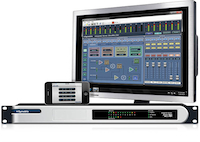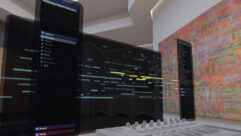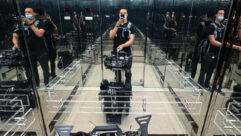

Symetrix Zone Mix 761 Mixer
Dec 7, 2011 3:21 PM,
by John McJunkin
A sophisticated device with simple I/O accomodations.
Symetrix Zone Mix 761 Mixer
I first reviewed the Symetrix Zone Mix 760 in these pages in February of 2008—and discovered a simple, straightforward product with some very useful and effective features. The 760 was exactly what its name implied: a mixer that facilitated signal routing to multiple zones and with the capacity to process a signal independently, or contingent upon signals carried by other channels (auto-ducking, for instance). The 760 also granted the capacity to deliver signal over Cat-5 cabling and computer-based control over the system—all-around a potent device. Now Symetrix has introduced an updated version, the Zone Mix 761, which improves on the original mixer in a number of ways, not the least of which is the capacity to take control of it via smartphone. I anticipated evaluating the revised unit to get a handle on the new features.
I pulled the unit from the shipping box, along with its power supply, documentation, and software CD-ROM. In consideration of the fact that the 761 has no front-panel controls whatsoever, connection with one’s computer is a must, so I proceeded directly to installing the software and getting the unit connected to my computer via Ethernet. The installation didn’t take long, and once I had the mixer connected to the computer, I launched the control application and selected the external connection wizard. The wizard auto-detected the 761 I’d connected and enabled me to connect it with the software and go online right away, as indicated by the flashing of the network LED on the 761’s front panel. Once I was online, I had immediate access to every parameter throughout the 761 system. The software also facilitates storage of as many configurations as you would ever need—the computer simply stores a snapshot of all the parameters or user-determined subset (Zone Presets). These presets can be recalled at any time, and the system can be password-secured as well. It was easy to connect audio inputs and outputs too. I had not planned on evaluating any of Symetrix’ ARC-dedicated physical controllers, so no connections in that domain were necessary. I have had experience with the ARC controllers, however, and they’re easily configured and can facilitate remote control over very deliberately chosen parameters, simplifying operation for non-professionals. Events can be scheduled with the software’s realtime clock as well.
The Zone Mix 761 is a 1RU device with simple input/output accommodations. The front panel is very stark, with nothing in the way of controls or indicators on the left half. The right half features LEDs that indicate signal presence, nominal level, and clipping for each of the unit’s 12 inputs and six outputs. There are also three LEDs to indicate power, network connection, and the presence of ARC control devices. Starting from left to right, the 761’s rear panel features a power inlet, two RJ-45 jacks representing ARC and Ethernet connections, and Euroblock jacks representing logic outputs, external control inputs, RS-485 and RS-232 computer connections, and six analog line outputs. Eight pairs of stereo RCA inputs represent channels 5-12, and another short Euroblock strip represents four balanced analog mic/line inputs. I really like the fact that the DC power input, which accepts current from a line-lump power supply, has a screw-on connector that prevents it from coming loose.
The Zone Mix 761’s mic/line inputs feature digital trim, mic/line attenuation, phantom power, polarity inversion, and a white/pink noise generator. Each of these four inputs also offers three bands of fully parametric EQ with low and high shelf filters on each input. A high-pass rumble filter rounds out the spectral control over the signal. A compressor is available on each of these four inputs, with threshold, ratio, attack, and release controls, along with selection of a soft, medium, or hard knee, and make-up gain. Metering here includes both output and gain reduction simultaneously. Each input channel also has an eight-filter feedback suppressor. The filters can be either fixed at user-defined frequencies and gain reduction or set to dynamically hunt for feedback. Five presets make it easier to configure the suppression, providing a baseline contingent upon room size and whether music is in the mix or not. The 761’s RCA “audio media” inputs each have digital trim controls and an automatic gain control processor, with a simple single-fader target-output-level control.
Each of the 761’s six outputs has an 8-band fully parametric EQ with high- and low-pass filters in three topologies: Butterworth, Bessel, and Linkwitz-Riley, each with slopes of 6, 12, 18, 24, 30, 36, 42, and 48dB/octave. Polarity can also be inverted, and a delay of up to 341ms can be applied. If the delay is less than 100ms, resolution is 1/10th of a millisecond. It’s not very often I’ll get this precise with delay times, but I appreciate the capacity to do so. Each of the six outputs also features a limiter with threshold and release time controls, and output and simultaneous gain reduction metering. Output level is set on this page of the graphical user interface as well, either +4dBu or -10dBv. There are mute buttons on all inputs and outputs, and there is a single mute-outputs button at the top of the interface to quickly end all audio. The actual zone mixer allows up to three stations for ducking control, two separate duckers, station priority control for the three stations, and SPL-controlled auto-gain for the first three zones. I really appreciate having the capacity to automate control over BGM level based on room ambience, and the Zone Mix 761 offers sophisticated control over this automation.
Symetrix Zone Mix 761 Mixer
Dec 7, 2011 3:21 PM,
by John McJunkin
A sophisticated device with simple I/O accomodations.
The final two pages of the graphical user interface are a matrix for zone-to-output signal routing and page station set-up. The software also has an external controller wizard to configure dedicated physical controllers. An extensive help menu is also included, and I was easily able to get answers to my questions therein. I put signal through the system in order to hear the digital signal processing, and as has always been the case when I evaluate Symetrix’ devices, it sounded great. The ducking works well, and the dynamics processors sound great too. The huge step up for Symetrix with this device over its predecessor, the 760, is the capacity to control it remotely with a smartphone or any other device with a browser. Symetrix’ ARC-WEB web server facilitates this control, and it literally allows the user to emulate ARC physical controls from any computer with Internet Explorer, Safari, or Firefox, and via browsers on iPhone and Android devices. I was concerned that the configuration and set up of browser-based control would be very complex, but I was pleasantly surprised at how simple it was. I really like this development, since it facilitates control over all the zones of an entire establishment via one single smartphone, which could be simply carried around by a manager or entertainment coordinator—this is very powerful. It also accomplishes a goal I have desired for quite some time: the capacity to control a Symetrix system with an Apple computer. Make no mistake, a Windows computer is still necessary for the process, but ultimately, control can be initiated from a Mac—another big step up for Symetrix.
I had been impressed with the function of the Zone Mix 760, and with the new additional capabilities, the device is even more valuable in my mind. The capacity to control the system remotely from a smart device or computer browser alone will make it popular with establishment owners, and I’m guessing that contractors will be specifying it for a substantial number of installs. Well done, Symetrix.
John McJunkin is the principal of Avalon Podcasting in Chandler, Ariz. He has consulted in the development of studios and installations and provides high-quality podcast production services.
Product Summary
- Company: Symetrix
- Product: Zone Mix 761 Mixer
www.symetrix.co - Pros: Remote, browser-based control by smart phones and virtually any computer.
- Cons: A physical mute-all channels button on the front panel would be welcome.
- Applications: Zone mixing, paging, music management for restaurants, clubs, etc.
- Price: $1,649
Specifications
INPUTS
- Number of inputs: 12 total
4 switchable balanced mic or line
8 mono-summed stereo
(-10dBV line level) - Connectors: 3.81mm terminal blocks (mic/line)
RCA (Audio Media source) - Nominal input level: +4dBu line or -36dBu mic level
(software selectable) with 20dB of headroom - Mic preamp gain: +40dB
- Maximum input level: +23dBu mic/line, +8dBV RCA
- Input impedance: >18kΩ balanced, >9kΩ unbalanced,
>2kΩ with phantom power engaged (Euroblock)
>20kΩ unbalanced (RCA) - CMRR: >50dB@1kHz, unity gain
- Mic preamp EIN: <-125dBu, 22Hz-22kHz, 100Ω source impedance
- Phantom power: +20 VDC, 20 mA maximum per input
OUTPUTS
- Number of outputs: 6 balanced line level
- Connectors: 3.81mm terminal blocks
- Nominal output level: +4dBu line level with 20dB of headroom
- Maximum output level: +24 dBu
- Output impedance: 200Ω balanced, 100Ω unbalanced
SYSTEM
- Sample rate: 48kHz
- Frequency response: 20Hz-20kHz, ±0.5dB
- Dynamic range: >110dB (A-Weighted), input to output
- THD+Noise: <-85dB (un-weighted)
1kHz@+22dBu with 0dB gain - Interchannel crosstalk: <-90dB@1kHz, typical
- Latency: <1.6ms, input to output, all DSP inactive









